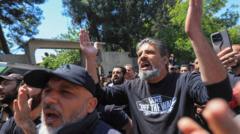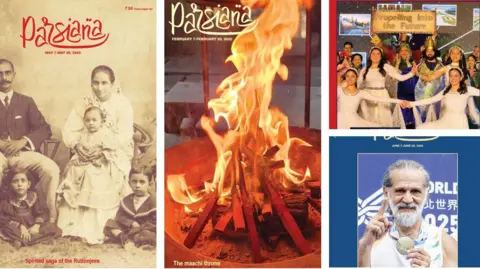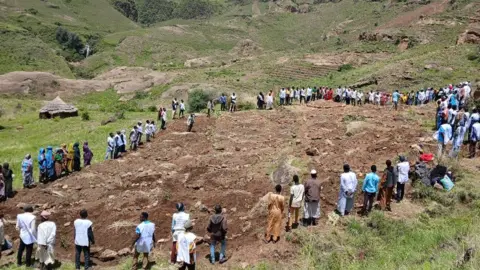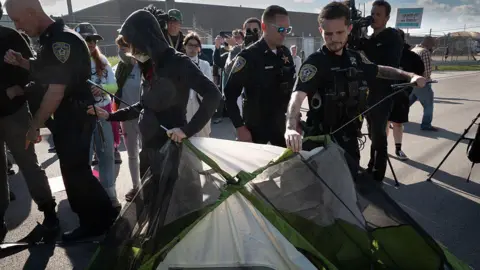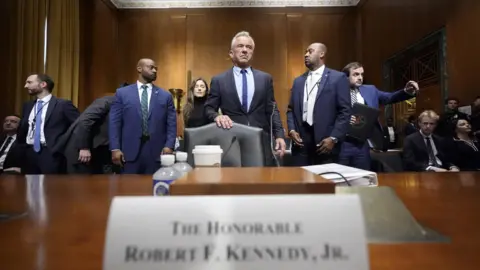In the Damascus suburb of Ashrafiyat Sahnaya, residents are reeling from recent sectarian violence that has left the Druze community feeling increasingly vulnerable. Lama al-Hassanieh, who lives in the area, recalls the moment when the chaos erupted. In fear, she barricaded herself in her bathroom as armed individuals roamed outside, shouting anti-Druze slogans.
The Druze, a minority group with unique beliefs emerging from Shia Islam, have maintained a complex relationship with Syrian power structures, particularly under former President Bashar al-Assad. Initially viewing alignment with the state as a means of safeguarding against the civil war's sectarian violence, the community is now experiencing a palpable shift in their safety and security amid state failures.
Recent events have worsened fears, following a viral audio recording that instigated backlash against the Druze. It led to fatal clashes in which over 137 individuals were killed, including civilians and security personnel. The legitimacy of these attackers remains uncertain, igniting suspicions that Druze may face increased hostility in a post-war climate that favors a Sunni-dominated governance.
Lama Zahereddine, a pharmacy student, similarly recounts horrifying experiences of violence reaching her village, forcing her to flee under duress while her community faced overwhelming firepower. These incidents were compounded at local universities, where Druze students faced physical threats and hostility.
As sentiment towards the government deteriorates, maintaining safety has become a pressing concern for the Druze. Many find themselves questioning who to trust, even amongst peers. Social media reactions to their plight reflect a troubling reality of mistrust and division, exacerbating an already precarious situation.
In their attempts to re-establish safety, Druze volunteers have banded together, but stories of ambush and attack continue to instill fear. Hadi Abou Hassoun, who volunteered to protect his community, was himself injured during an ambush, leaving him with significant physical injuries and deepening concerns about the state's capacity for ensuring security.
As Israel conducts airstrikes under the pretext of protecting the Druze from militant actions, local sentiments remain mixed. While the situation may appear calmer in Ashrafiyat Sahnaya now, the shadow of mistrust and the concern for accountability remain.
Lama al-Hassanieh articulates the crux of the issue facing the Druze: a yearning for acknowledgment, justice, and the reaffirmation of their rights as Syrians, rather than as mere minorities in a shifting landscape of power and identity.
The ongoing strife underscores the vulnerability of minority groups amidst broader political turmoil in Syria, prompting critical questions about the future of coexistence in a deeply divided society.
The Druze, a minority group with unique beliefs emerging from Shia Islam, have maintained a complex relationship with Syrian power structures, particularly under former President Bashar al-Assad. Initially viewing alignment with the state as a means of safeguarding against the civil war's sectarian violence, the community is now experiencing a palpable shift in their safety and security amid state failures.
Recent events have worsened fears, following a viral audio recording that instigated backlash against the Druze. It led to fatal clashes in which over 137 individuals were killed, including civilians and security personnel. The legitimacy of these attackers remains uncertain, igniting suspicions that Druze may face increased hostility in a post-war climate that favors a Sunni-dominated governance.
Lama Zahereddine, a pharmacy student, similarly recounts horrifying experiences of violence reaching her village, forcing her to flee under duress while her community faced overwhelming firepower. These incidents were compounded at local universities, where Druze students faced physical threats and hostility.
As sentiment towards the government deteriorates, maintaining safety has become a pressing concern for the Druze. Many find themselves questioning who to trust, even amongst peers. Social media reactions to their plight reflect a troubling reality of mistrust and division, exacerbating an already precarious situation.
In their attempts to re-establish safety, Druze volunteers have banded together, but stories of ambush and attack continue to instill fear. Hadi Abou Hassoun, who volunteered to protect his community, was himself injured during an ambush, leaving him with significant physical injuries and deepening concerns about the state's capacity for ensuring security.
As Israel conducts airstrikes under the pretext of protecting the Druze from militant actions, local sentiments remain mixed. While the situation may appear calmer in Ashrafiyat Sahnaya now, the shadow of mistrust and the concern for accountability remain.
Lama al-Hassanieh articulates the crux of the issue facing the Druze: a yearning for acknowledgment, justice, and the reaffirmation of their rights as Syrians, rather than as mere minorities in a shifting landscape of power and identity.
The ongoing strife underscores the vulnerability of minority groups amidst broader political turmoil in Syria, prompting critical questions about the future of coexistence in a deeply divided society.

